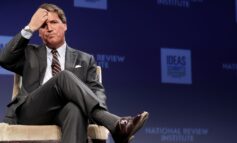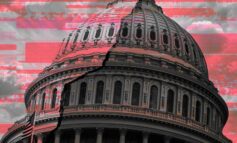On April 7, Terry Jones, the Qur’an-burning pastor from Florida, stood in front of the Islamic Center of America to condemn Islamic religious law (shari’a) and the alleged Muslim effort to sabotage the Constitution. He renounced the Christian churches for criticizing him. As a professor who teaches about Religion and Politics, I was there to see what I could learn.

|
| Stockton (R) is seen here surrounded by BAMN members. Photo courtesy of Dearborn Patch/Ian Kushnir |
The police were out in force, perhaps 30 cars, 200 officers, and two canines. Twenty demonstrators from BAMN (By Any Means Necessary, a confrontational, aggressive group from Detroit), were kept a hundred yards from Jones. They were chanting, “Terry Jones, hell no, racist dogs have to go.” They have strong lungs and repeated this chant over and over.
There seemed to be no Muslim protestors. This is in contrast to what happened a year ago when Jones spoke on the steps of city hall. Then BAMN had incited angry Muslim youths to charge police lines. Riot police stood with face shields down and truncheons at the ready. Fortunately, some elders rushed into oncoming traffic to save those foolish young men from a head smashing. Back then, mosque leaders had unsuccessfully asked everyone to ignore Jones and deny him publicity. This time their request worked, except for BAMN.
Jones made his predictable talk without disruption.
Leaving the event, I paused briefly to read the BAMN signs. They started chanting louder and louder, now saying, “Racist dog has to go.” It used to be dogs but now it was singular. When they said “racist” they would look directly at me and shout the word. The BAMN group started walking towards me, shouting “racist” even louder. They were getting themselves into a froth. I tried to walk away but suddenly found myself completely surrounded by a tight circle of people chanting “racist” in unison. To say I was shaken would be an understatement.
Just for the record, I was wearing a burgundy Land’s End sweater, carrying a rolled-up poster from the event and a camera. I was also wearing my white hair. This was not the Jones Entourage uniform. Jones was wearing a black leather jacket with jeans and cowboy boots (and packing heat, as were some followers). Others had baseball caps, jeans, and sweatshirts with militant slogans. I definitely did not look a part of that group. There was only one thing to put me into the “racist” category, which makes “racist” a pretty sweeping category.
I knew I was in some danger, surrounded by a dozen chanting, screaming people with hatred in their faces. They were in a venomous frenzy. As that circle tightened I knew not to move or speak. A reporter had told me of an incident earlier when BAMN had attacked Jones supporters, shoving them and knocking a female (African-American) to the ground. The police had to rescue them. They had also verbally assaulted a neighbor (white) who was walking with his wife. This group has a predisposition to verbal excess and physical action.
Fortunately, two police officers stepped forward. One (who was black) walked into the circle and said in a very gentle manner, “Come. Walk away.” I started walking to my car, fifty feet down the road. The chanting mob followed me. The look of hatred on their faces was chilling. I had ceased to be a person and had become some monster. I was very happy to see those squad cars nearby, and the scores of officers. Those police were very professional in a difficult situation. I admired them.
I came away from this event with two thoughts. The first is that BAMN and Reverend Jones are mirror images of each other. Both have self-righteous rage, both have created an abstracted evil that they see as worthy of destruction, both think in terms of sweeping categories of people (Muslim radicals, racists) that omit nuance or human complexity, or contradictory data, and both engage in verbal violence so extreme that it can easily escalate into physical assaults (although Jones has not gone beyond words).
My second insight was personal. I teach about ethnic violence, and have spoken to and read about people caught up in such violence. Nothing that happened here surprised me. But at a personal level, I learned something ugly. I saw first hand what it was to be targeted by a mob. I knew that if it were not for those police, I could have been beaten. I sensed what it was to be a Tutsi in Rwanda, a Muslim in Bosnia, a Palestinian delivery boy in West Jerusalem when a bomb goes off, a Sikh in Delhi after the assassination of Indira Gandhi, a Jew in the 1800s having a mob shouting “Hep Hep,” or Trayvon Martin.
Ten minutes from my house and three minutes from my office, I was afraid.
Professor Stockton teaches at the University of Michigan-Dearborn. He made four pages of notes on the Jones talk. For a copy, contact him at Rstock@Umich.edu.





Leave a Reply